towing BUICK PARK AVENUE 1993 Owners Manual
[x] Cancel search | Manufacturer: BUICK, Model Year: 1993, Model line: PARK AVENUE, Model: BUICK PARK AVENUE 1993Pages: 340, PDF Size: 18.17 MB
Page 80 of 340
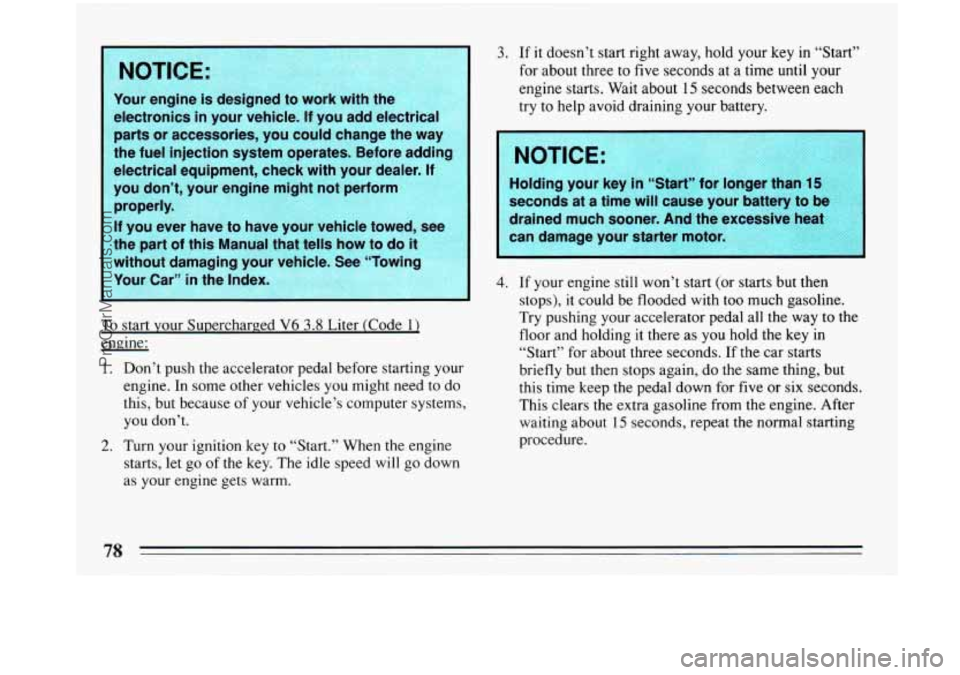
Your engine is designed to work with the
electronics in your vehicle.
If you add electrical
parts or accessories, you could change the way
If you ever have to have your vehicle towed, see
the part
of this Manual that tells how to do it
without damaging your vehicle. See “Towing
Your Car” in the Index.
To start your SupercharEed V6 3.8 Liter (Code 1)
engine:
1.
2.
Don’t push the accelerator pedal before starting your
engine. In some other vehicles you might need to do
this, but because
of your vehicle’s computer systems,
you don’t.
Turn your ignition key to “Start.” When the engine
starts, let go
of the key. The idle speed will go down
as your engine gets warm.
3. If it doesn’t start right away, hold your key in “Start”
for about three to five seconds at a time until your
engine starts. Wait about
15 seconds between each
try to help avoid draining your battery.
4. If your engine still won’t start (or starts but then
stops),
it could be flooded with too much gasoline.
Try pushing your accelerator pedal all the way to the
floor and holding
it there as you hold the key in
“Start” for about three seconds. If the car starts
briefly but then stops again, do the same thing, but
this time keep the pedal down for five or six seconds.
This clears the extra gasoline from the engine. After
waiting about
15 seconds, repeat the normal starting
procedure.
78
ProCarManuals.com
Page 83 of 340
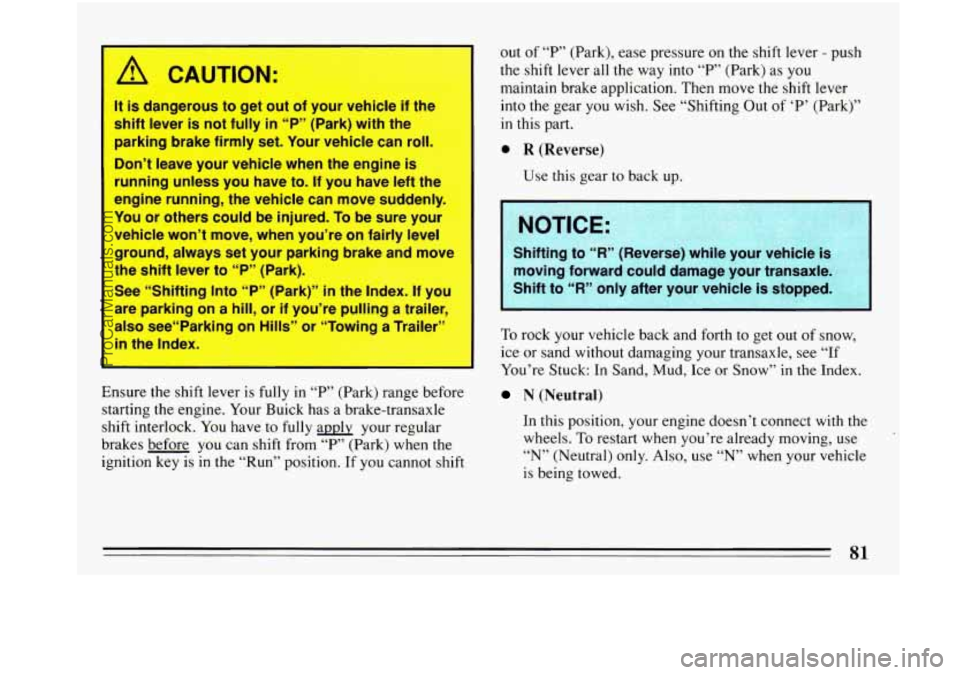
I A CAUTION:
It is dangerous to get out of your vehicle if the
shift lever is not fully
in “P” (Park) with the
parking brake firmly set. Your vehicle can roll.
Don’t leave your vehicle when the engine is
running unless you have to.
If you have left the
engine running, the vehicle can move suddenly.
You or others could be injured. To be sure your
vehicle won’t move, when you’re on fairly level
ground, always set your parking brake and move
the shift lever to “P” (Park).
See “Shifting Into “P” (Park)”
in the Index. If you
are parking on a
hill, or if you’re pulling a trailer
also see“Parking on Hills” or “Towing a Trailer’
in the Index.
Ensure the shift lever is fully in “P” (Park) range before
starting the engine. Your Buick has a brake-transaxle
shift interlock. You have
to fully apply your regular
brakes before you can shift from “P” (Park) when the
ignition key is in the “Run” position. If you cannot shift out
of
“P” (Park), ease pressure on the shift lever - push
the shift lever all the way into
“P” (Park) as you
maintain brake application. Then move the shift lever
into the gear you wish. See “Shifting Out
of ‘P’ (Park)”
in this part.
0 R (Reverse)
Use this gear to back up.
Shifting to ‘W’ (Reverse) while your vehicle is
moving forward could damage your transaxle.
Shift to
“R” only after your vehicle is stoppc
To rock your vehicle back and forth to get out of snow,
ice or sand without damaging your transaxle, see
“If
You’re Stuck: In Sand, Mud, Ice or Snow” in the Index.
N (Neutral)
In this position, your engine doesn’t connect with the
wheels.
To restart when you’re already moving, use
“N” (Neutral) only. Also, use “N” when your vehicle
is being towed.
ProCarManuals.com
Page 84 of 340
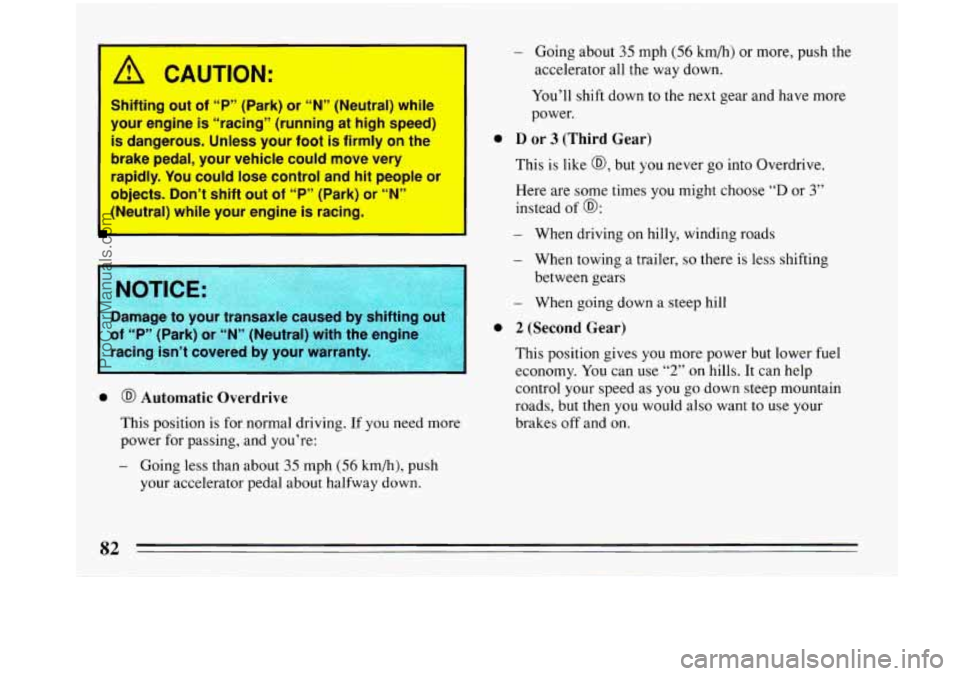
I
A CAUTION:
Shifting out of “PYy (Park) or “N” (Neutral) while
’ your engine is “racing” (running at high speed)
is dangerous. Unless your foot
is firmly on the
brake pedal, your vehicle could move very
rapidly. You could lose control and hit people or
objects. Don’t shift out of “P” (Park) or “N”
I (Neutral) while your engine is racing.
Damage to your tia,lsaxI
Going about 35 mph (56 km/h) or more, push the
accelerator all the way down.
You’ll shift down
to the next gear and have more
power.
0 D or 3 (Third Gear)
This is like @, but you never go into Overdrive.
Here are some times you might choose
“D or 3”
instead of @:
- When driving on hilly, winding roads
- When towing a trailer, so there is less shifting
between gears
- When going down a steep hill
0 2 (Second Gear)
This position gives you more power but lower fuel
economy. You can use
“2” on hills. It can help
control your speed as
you go down steep mountain
roads, but then you would also want to use your
brakes off and on. 0 @ Automatic Overdrive
This position is for normal driving. If you need more
power for passing, and you’re:
- Going less than about 35 mph (56 km/h), push
your accelerator pedal about halfway down.
82
ProCarManuals.com
Page 87 of 340
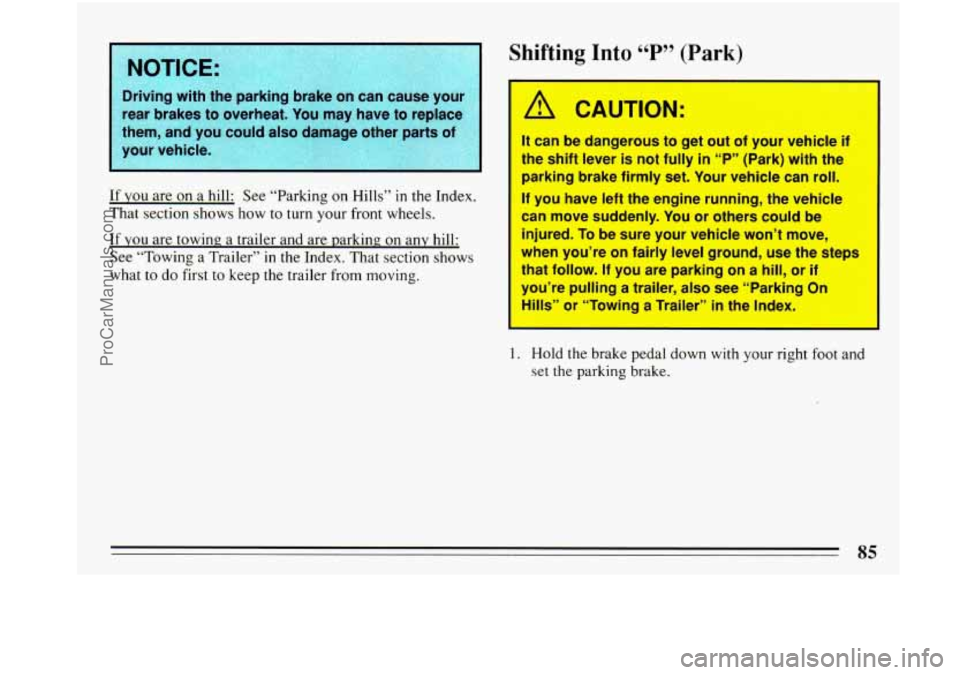
Driving with the parking brake on can cause youkz.,--.I
rear brakes to overheat.
You may have to replace-
them, and you could also damage other parts of
If YOU are on a hill: See “Parking on Hills” in the Index.
That section shows how to turn your front wheels.
If you are towing a trailer and are parking on any hill:
See “Towing a Trailer”
in the Index. That section shows
what
to do first to keep the trailer from moving.
Shifting Into “P” (Park)
A CAUTION:
It can be dangerous to get out of your vehicle if
the shift lever is not fully in “P” (Park) with the
parking brake firmly set. Your vehicle can roll.
If you have left the engine running, the vehicle
can move suddenly. You or others could be
injured. To be sure your vehicle won’t move,
when you’re on fairly level ground, use the steps
that follow.
If you are parking on a hill, or if
you’re pulling a trailer, also see “Parking On
H”‘ ;” or “Towing a Trailer” in the Index.
1. Hold the brake pedal down with your right foot and
set
the parking brake.
ProCarManuals.com
Page 91 of 340

Running Your Engine While You’re
Parked
It’s better not to park with the engine running. But if you
ever have to, here are some things to know.
b!, CAUTION:
Idling the engine with the air system control off
could allow dangerous exhaust into your vehicle
(see the earlier Caution under “Engine Exhaust”).
Also, idling in a closeddn place can let deadly
carbon monoxide
(CO) into your vehicle even if
the fan switch
is at the highest setting. One place
this can happen is a garage. Exhaust -- with CO --
can come in easily. NEVER park in a garage with
the engine running.
-
Another closed-in place can be a blizzard. (See
“Blizzard” in the Index.)
CAUTION: (Continued)
CAUTION: (Continued)
It can be dangerous to get out of your vehicle if
the
shift lever is not fully in “Pyy (Park) with the
parking brake firmly set. Your vehicle can
roll.
Don’t leave your vehicle when the engine is
running unless you have to. If you’ve left the
engine running, the vehicle can move suddenly.
You
or others could be injured. To be sure your
vehicle won’t move, even when you’re on fairly
level ground, always set your parking brake and
move the shift lever to
“P” (Park).
Follow the proper steps to
be sure your vehicle
won’t move.
See “Shifting Into ’P‘ (Park)” in the
Index.
If you are parking on a hill, or if you’re pulling a
trailer, also see “Parking
on Hills” or “Towing a
Trailer”
in the Index.
ProCarManuals.com
Page 94 of 340
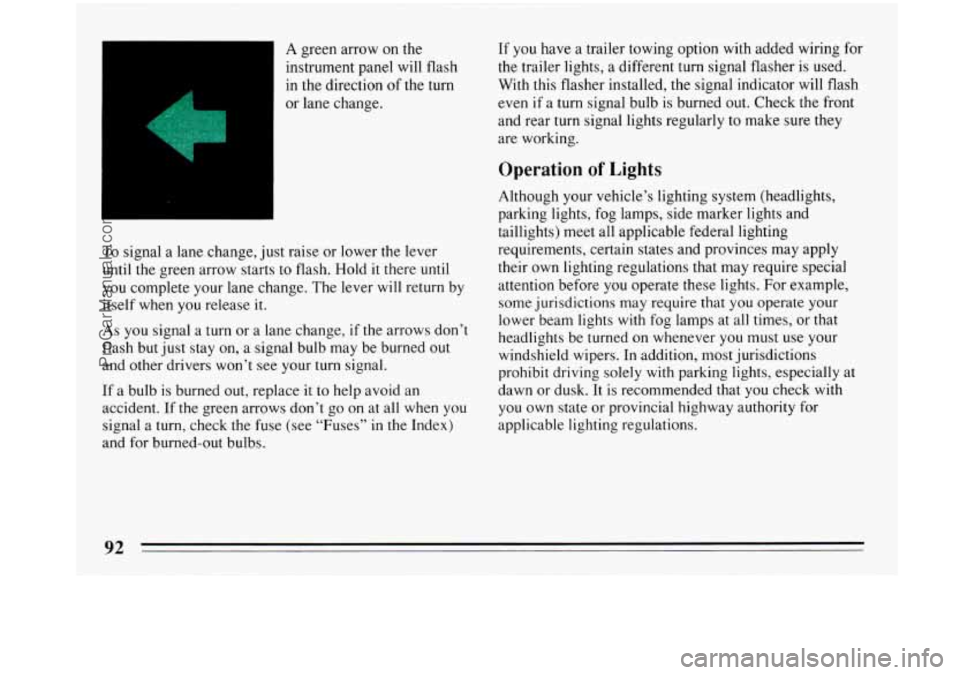
A green arrow on the
instrument panel
will flash
in the direction of the turn
or lane change.
To signal a lane change, just raise or lower the lever
until
the green arrow starts to flash. Hold it there until
you complete your lane change. The lever will return by
itself when you release it.
As you signal a turn or a lane change, if the arrows don’t
flash but just stay on, a signal bulb may be burned out
and other drivers won’t see your turn signal.
If a bulb is burned out, replace it to help avoid an
accident. If
the green arrows don’t go on at all when you
signal a turn, check the fuse (see “Fuses”
in the Index)
and for burned-out bulbs.
If you have a trailer towing option with added wiring for
the trailer lights, a different turn signal flasher is used.
With this flasher installed, the signal indicator will flash
even
if a turn signal bulb is burned out. Check the front
and rear turn signal lights regularly to make sure they
are working.
Operation of Lights
Although your vehicle’s lighting system (headlights,
parking lights, fog lamps, side marker lights and
taillights) meet all applicable federal lighting
requirements, certain states and provinces may apply
their own lighting regulations that may require special
attention before
you operate these lights. For example,
some jurisdictions may require that you operate your
lower beam lights with fog lamps at all times, or that
headlights be turned on whenever you must use your
windshield wipers. In addition, most jurisdictions
prohibit driving solely with parking lights, especially at
dawn or dusk. It is recommended that
you check with
you own state or provincial highway authority for
applicable lighting regulations.
ProCarManuals.com
Page 122 of 340
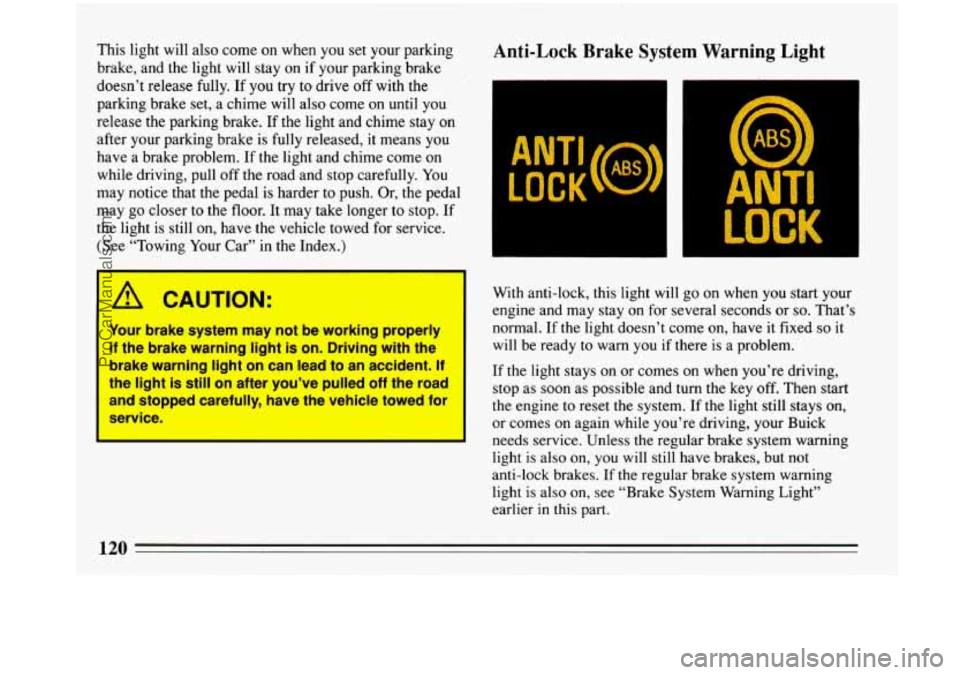
This light will also come on when you set your parking
brake, and the light will stay on if your parking brake
doesn’t release fully. If
you try to drive off with the
parking brake set, a chime will also come
on until you
release the parking brake. If the light and chime stay on
after your parking brake is fully released, it means
you
have a brake problem. If the light and chime come on
while driving, pull
off the road and stop carefully. You
may notice that the pedal is harder to .push. Or, the peda
may go closer to the floor. It may take longer
to stop. If
the light
is still on, have the vehicle towed for service.
(See “Towing Your Car” in the Index.)
I -
A CAUTION:
Your brake system may not be working properly
if the brake warning light is on. Driving with the
brake warning light on can lead to an accident.
If
the light is still on after you’ve pulled off the road
and stopped carefully, have the vehicle towed for
service.
1
Anti-Lock Brake System Warning Light
With anti-lock, this light will go on when you start your
engine and may stay on for several seconds or
so. That’s
normal. If the light doesn’t come on, have it fixed
so it
will be ready to warn
you if there is a problem.
If the light stays
on or comes on when you’re driving,
stop as soon as possible and turn the key
off. Then start
the engine
to reset the system. If the light still stays on,
or comes on again while you’re driving, your Buick
needs service. Unless the regular brake system warning
light
is also on, you will still have brakes, but not
anti-lock brakes.
If the regular brake system warning
light
is also on, see “Brake System Warning Light”
earlier
in this part.
ProCarManuals.com
Page 161 of 340
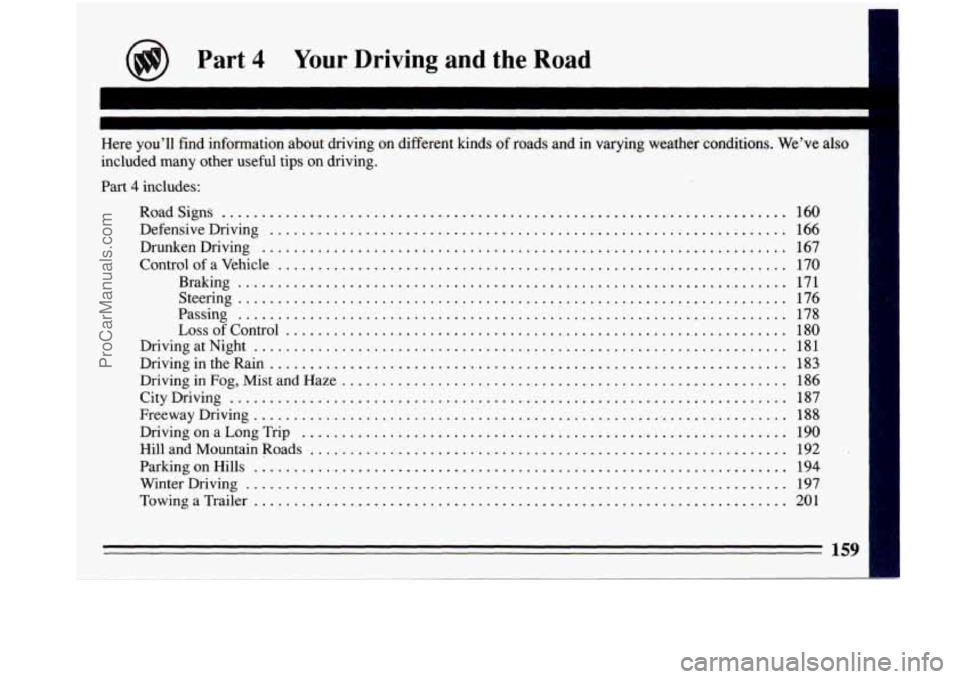
@ Part 4 Your Driving and the Road
~ . ~~~~~ ~~~ ~ ~ ~~ ~ ~~ ~ ~~ ~ ~ ~~ ~ ~
Here you’ll find information about driving on different kinds of roads and in varying weather conditions . We’ve also
included many other useful tips on driving
.
Part 4 includes:
RoadSigns
....................................................................... \
DefensiveDriving .................................................................
DrunkenDriving ................................................................
Control of a Vehicle ......................... ...................................
Braking .....................................................................
Steering .....................................................................
Passing .....................................................................
LossofControl ...............................................................
DrivingatNight ...................................................................
DrivingintheRain .................................................................
Driving in Fog, Mist and Haze ........................................................
CityDriving ......................................................................
FreewayDriving ...................................................................
DrivingonaLongTrip .............................................................
HillandMountainRoads ............................................................
ParkingonHills ...................................................................
TowingaTrailer ...................................................................
WinterDriving ....................................................................
160
166
167 170
171
176
178
180
181
183 186
187
188
190
192 194
197
201
ProCarManuals.com
Page 203 of 340
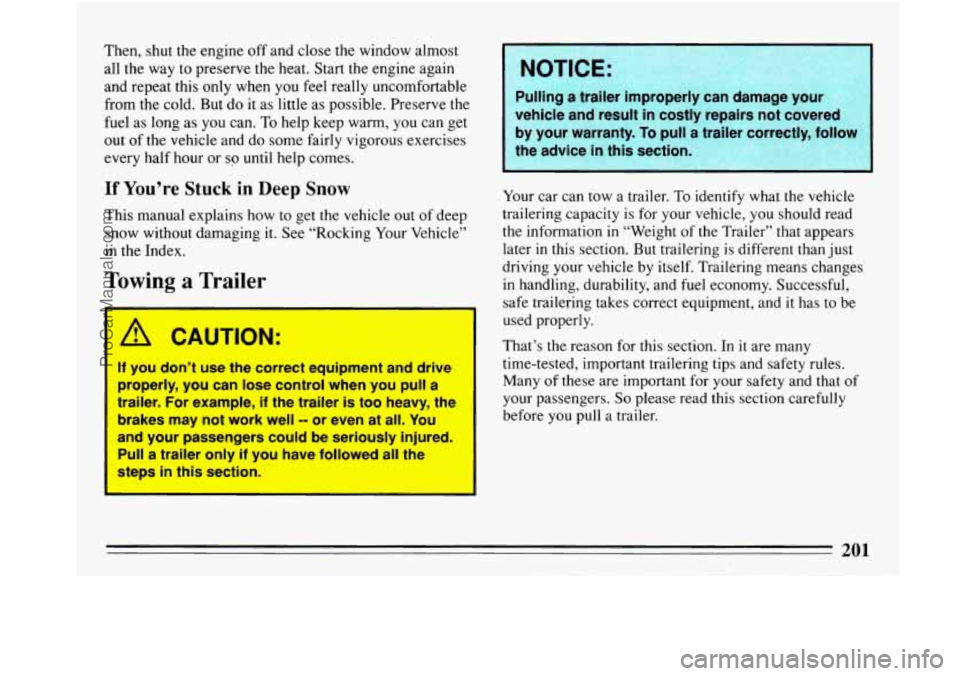
Then, shut the engine off and close the window almost
all the way to preserve the heat. Start the engine again
and repeat this only when
you feel really uncomfortable
from the cold. But do it as little as possible. Preserve the
fuel as long as you can. To help keep warm, you can get
out of the vehicle and do some fairly vigorous exercises
every half hour
or so until help comes.
If You’re Stuck in Deep Snow
This manual explains how to get the vehicle out of deep
snow without damaging it. See “Rocking Your Vehicle”
in the Index.
Towing a Trailer
1 A CAUTION:
If you don’t use the correct equipment and drive
properly, you can lose control when you pull a
trailer. For example, if the trailer
is too heavy, the
brakes may not work well
-- or even at all. You
and your passengers could be seriously injured.
Pull a trailer only if you have followed all the
steps
in this section. Pulling
a trailer
improperly can damage your
vehicle
and result in costly repairs not cover
by your warranty.
To pull
the advice
in this section
Your car can tow a trailer. To identify what the vehicle
trailering capacity is for your vehicle, you should read
the information in “Weight
of the Trailer” that appears
later in this section. But trailering is different than just
driving your vehicle by itself. Trailering means changes
in handling, durability, and fuel economy. Successful,
safe trailering takes correct equipment, and it has to be
used properly.
That’s the reason for this section, In it are many
time-tested, important trailering tips and safety rules.
Many
of these are important for your safety and that of
your passengers.
So please read this section carefully
before you pull a trailer.
201
ProCarManuals.com
Page 204 of 340
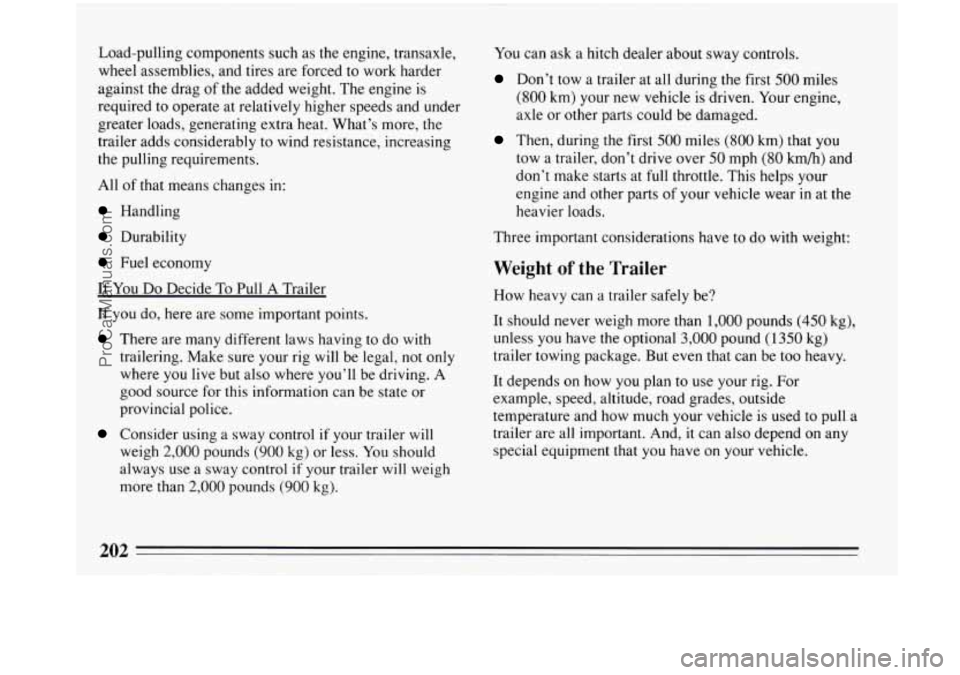
Load-pulling components such as the engine, transaxle,
wheel assemblies, and tires are forced to work harder
against the drag
of the added weight. The engine is
required to operate at relatively higher speeds and under
greater loads, generating extra heat. What’s more, the
trailer adds considerably
to wind resistance, increasing
the pulling requirements.
All of that means changes in:
Handling
Durability You
can ask a hitch dealer about sway controls.
Don’t tow a trailer at all during the first 500 miles
(800 km) your new vehicle is driven. Your engine,
axle or other parts could be damaged.
Then, during the first 500 miles (800 km) that you
tow a trailer, don’t drive over 50 mph (80 km/h) and
don’t make starts at
full throttle. This helps your
engine and other parts of your vehicle wear in at the
heavier loads.
Three important considerations have to do with weight:
Fuel economy
If You Do Decide To Pull A Trailer
If you do, here are some important points.
There are many different laws having to do with
trailering. Make sure your rig will be legal,
not only
where you live but also where you’ll be driving.
A
good source for this information can be state or
provincial police.
Consider using a sway control if your trailer will
weigh
2,000 pounds (900 kg) or less. You should
always use a sway control if your trailer will weigh
more than
2,000 pounds (900 kg).
Weight of the Trailer
How heavy can a trailer safely be?
It should never weigh more than
1,000 pounds (450 kg),
unless you have the optional
3,000 pound (1 350 kg)
trailer towing package. But even that can be too heavy.
It depends on how you plan to use your rig. For
example, speed, altitude, road grades, outside
temperature and how much your vehicle is used to pull
a
trailer are all important. And, it can also depend on any
special equipment that you have on your vehicle.
ProCarManuals.com